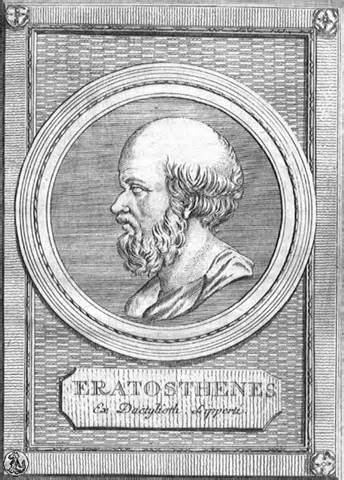Eratosthenes was a Greek expert in many disciplines, including astronomy, geography, and mathematics. He is most famous for his calculation of Earth's circumference and for inventing the word geography.
 Born in Cyrene, in what is now Libya, in 276 B.C., Eratosthenes grew up curious and went to Athens to learn more about the world around him. He studied at Plato's Academy and learned Stoicism from its founder, Zeno. He was learned in music and poetry as well, but he is most well-known for his achievements in mathematics and science.
Born in Cyrene, in what is now Libya, in 276 B.C., Eratosthenes grew up curious and went to Athens to learn more about the world around him. He studied at Plato's Academy and learned Stoicism from its founder, Zeno. He was learned in music and poetry as well, but he is most well-known for his achievements in mathematics and science.
He created an algorithm for determining prime numbers that is still in use today. It still bears his name: the Sieve of Eratosthenes. He used his mathematical knowledge and his geographical curiosity to perform his most famous experiment, the determination of Earth's circumference, in 240 B.C.
 Eratosthenes knew that at a well in Egypt, near Swenet (in Greek Syene and today Aswan), the Sun appeared directly overhead at precisely noon. He wasn't at the well when he made his calculation, however; rather, he was in Alexandria, where he was serving as head of the Great Library. He measured the angle of elevation of the Sun at noon in Alexandria and came up with a result of 1/50th south of the zenith. Alexandria was due north of Swenet, and Eratosthenes calculated that the distance between the two places was 1/50th of a circle's circumference, or 1/50th of 360 degrees, or 7 degrees and 12 minutes.
Eratosthenes knew that at a well in Egypt, near Swenet (in Greek Syene and today Aswan), the Sun appeared directly overhead at precisely noon. He wasn't at the well when he made his calculation, however; rather, he was in Alexandria, where he was serving as head of the Great Library. He measured the angle of elevation of the Sun at noon in Alexandria and came up with a result of 1/50th south of the zenith. Alexandria was due north of Swenet, and Eratosthenes calculated that the distance between the two places was 1/50th of a circle's circumference, or 1/50th of 360 degrees, or 7 degrees and 12 minutes.
Employing the distance between the two cities as 5,000 stadia (a distance known to many who traveled between the two cities), he then multipled that figure, 5,000, by 50 (360 divided 7.12) and got 250,000 stadia. A stadion in ancient Greece was thought to be the equivalent of 600 feet today, so 250,000 stadia was 150 million feet. That was Eratosthenes' estimate of Earth's circumference.
The real distance is 24,859 miles, or 131,259,849 feet. Eratosthenes wasn't too far wrong, and he didn't have the fancy instruments that geographers have today.
His other geographical accomplishments include reasonably accurate measurements of the tilt of Earth's axis, the distance from Earth to the Moon, and the distance from Earth to the Sun.
He was the first to use the word geography, employing it in a now-lost work titled Geographika. In this work, the contents of which are known because of references from subsequent books still in existence, Eratosthenes divided the planet into climate zones and employed overlapping grid lines onto maps of Earth. Geographika also listed the names and locations of 400 cities.
He wrote other books, including Chronographies, a scientific analysis of historical dates; Olympic Victors, a chronological listing of winners at the Olympics; works on grammar and rhetoric; and even plays and poems. He also essentially invented the leap day and year, using predictions about planetary movements.
He died in 194 B.C., at age 82.